Design and analysis of an inset-fed circle patch microstrip antenna operated at 28 GHz for 5G application
This paper presents a microstrip antenna design which it's radiating
element is circular and applied to 5G systems. The model and parameters of the
antenna were simulated and analyzed by High-Frequency Structure Simulator (HFSS)
computer code on FR4-epoxy laminate microwave. The simulation results of the
antenna show that it operates at 28 GHz with return loss S11= -40 dB, bandwidth
BW=2 GHz, power gain greater than 5 dB, radiation efficiency greater than 87% and
Voltage Standing Wave Ratio (VSWR) is less than 2 in the operating band from 26.8
to 28.8 GHz, respectively. From the results achieved, the designed antenna is suitable
to be used in devices using 5G technology
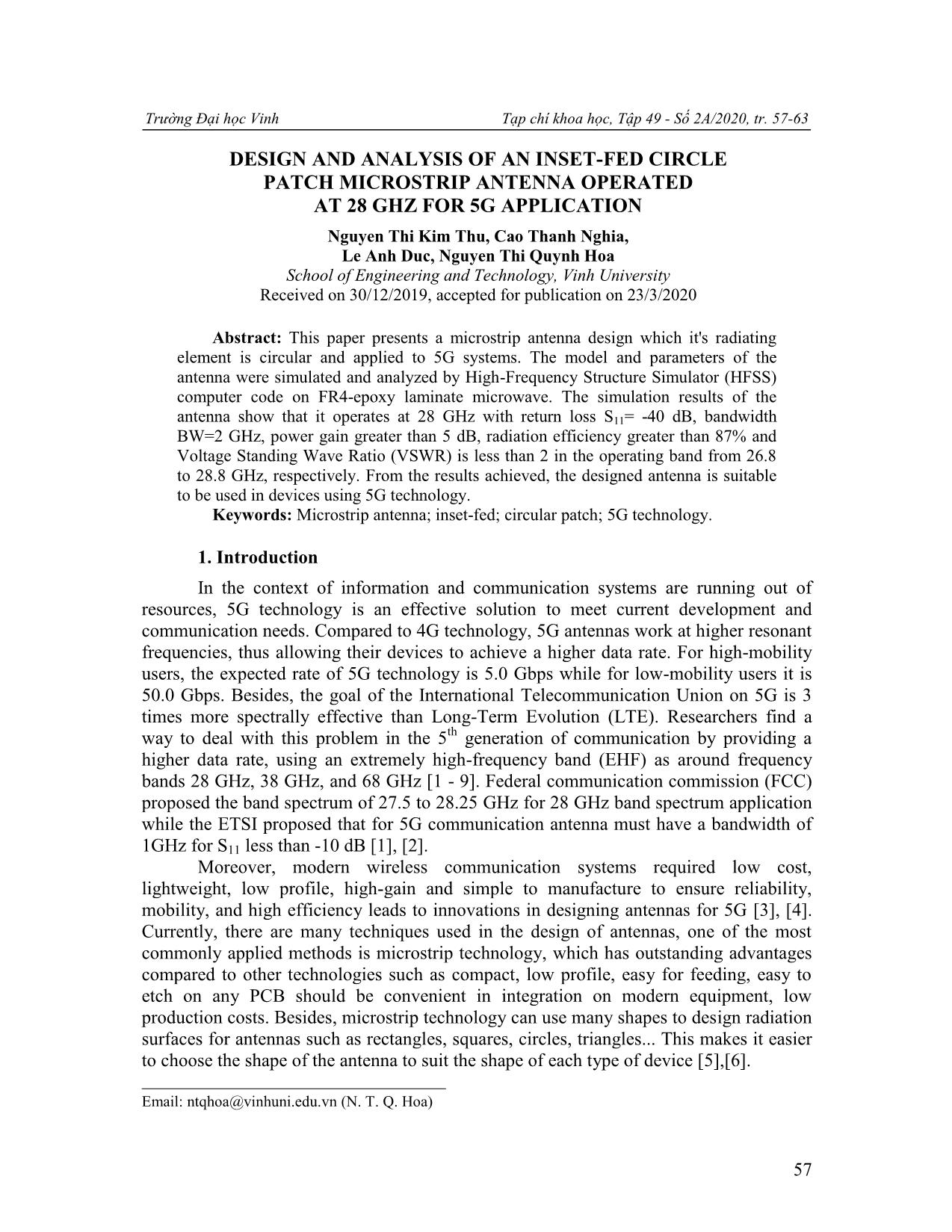
Trang 1
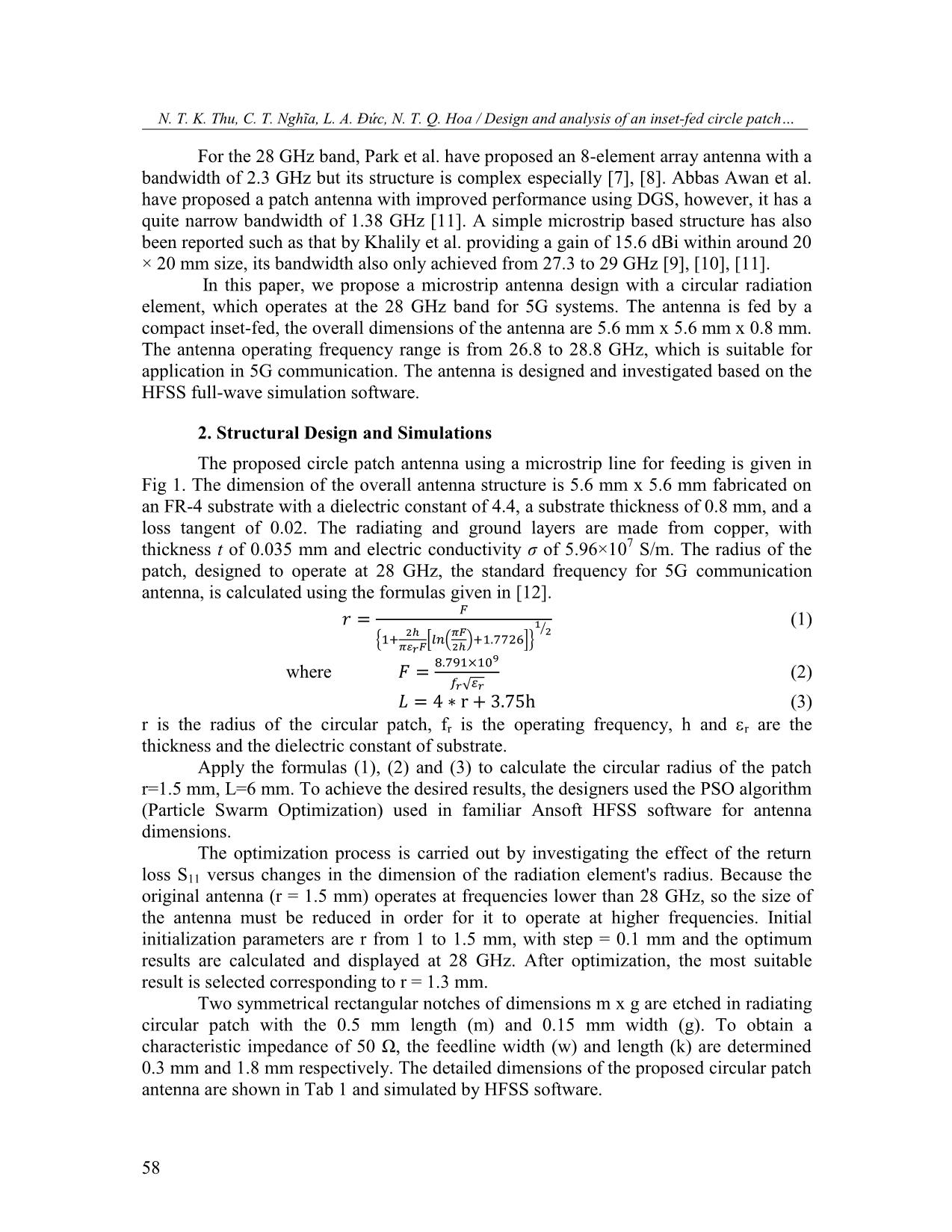
Trang 2
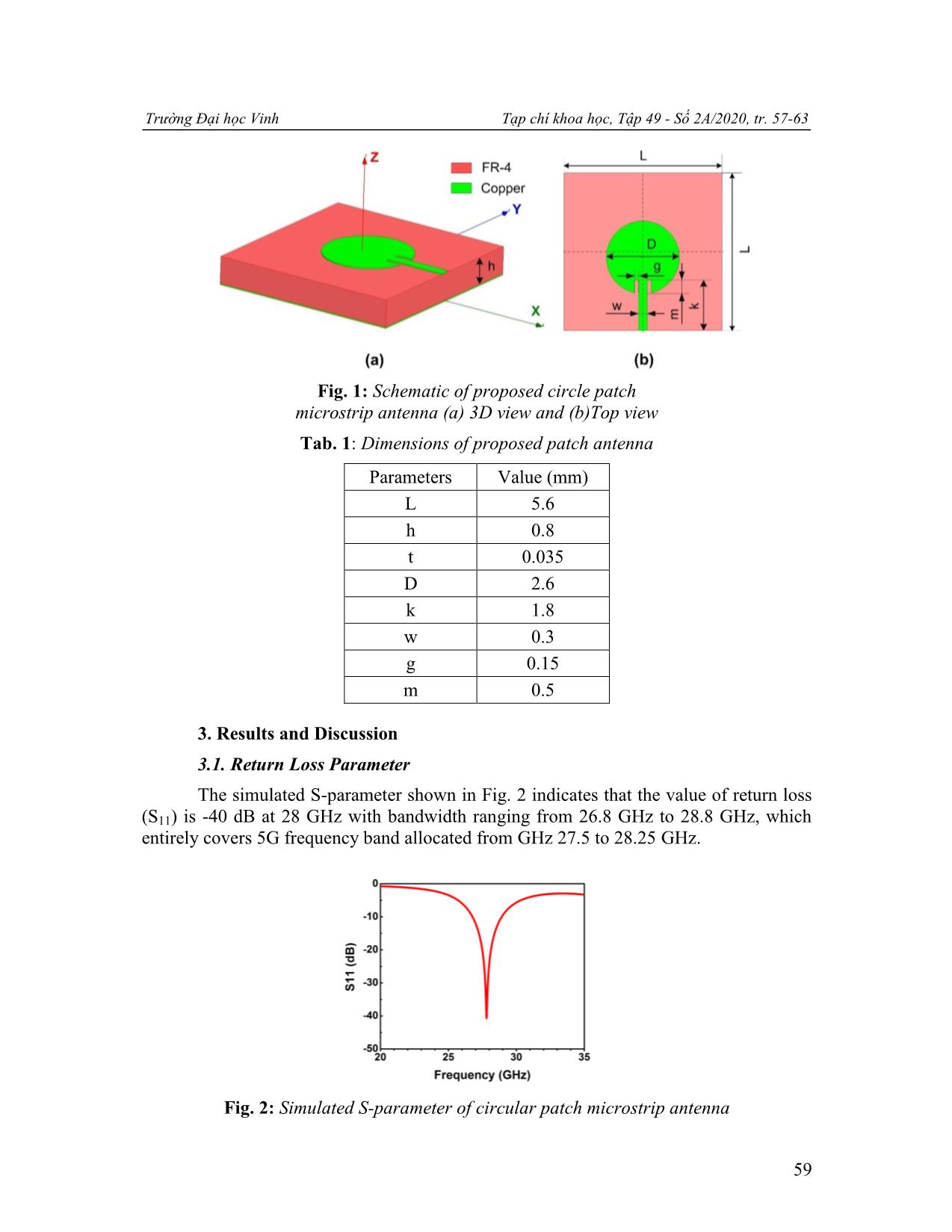
Trang 3

Trang 4
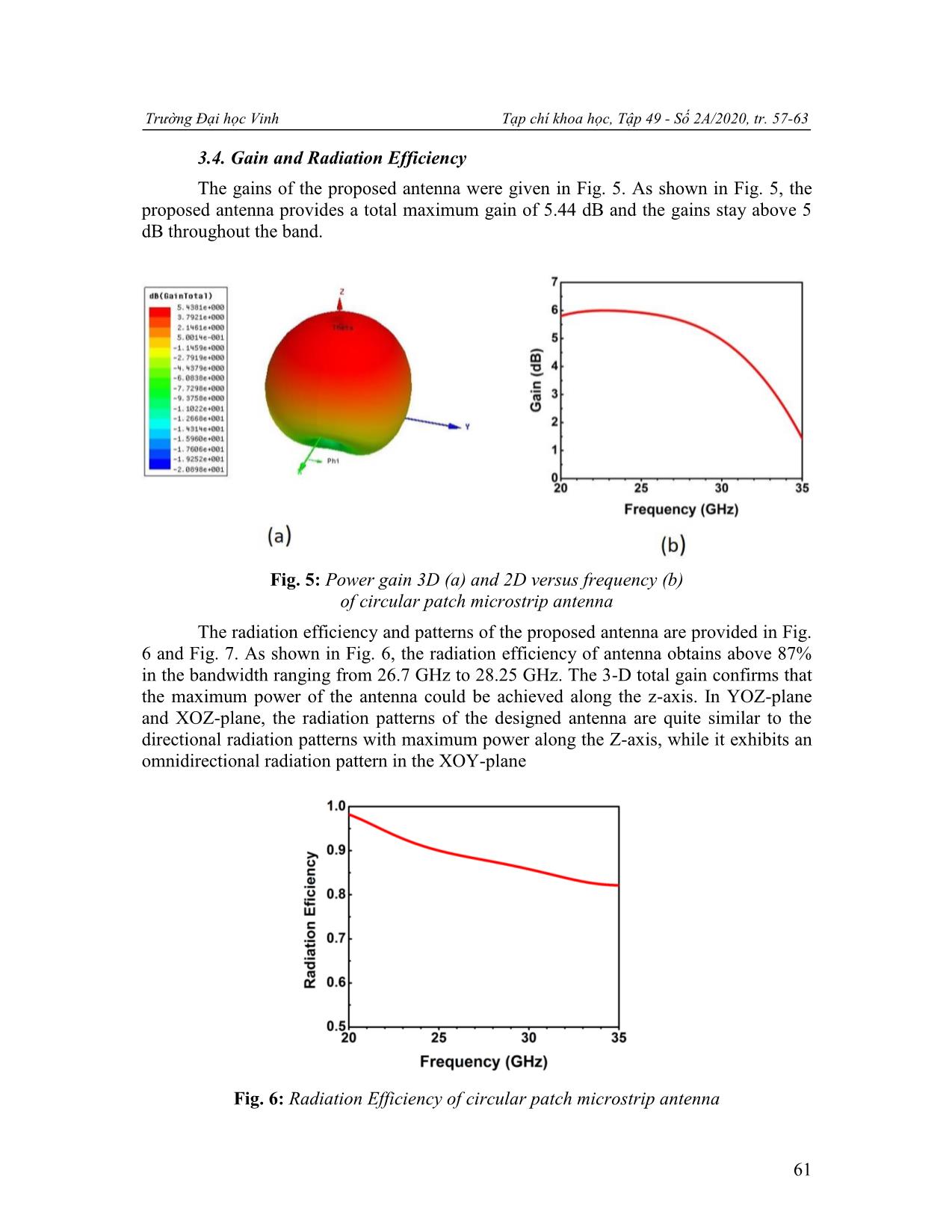
Trang 5
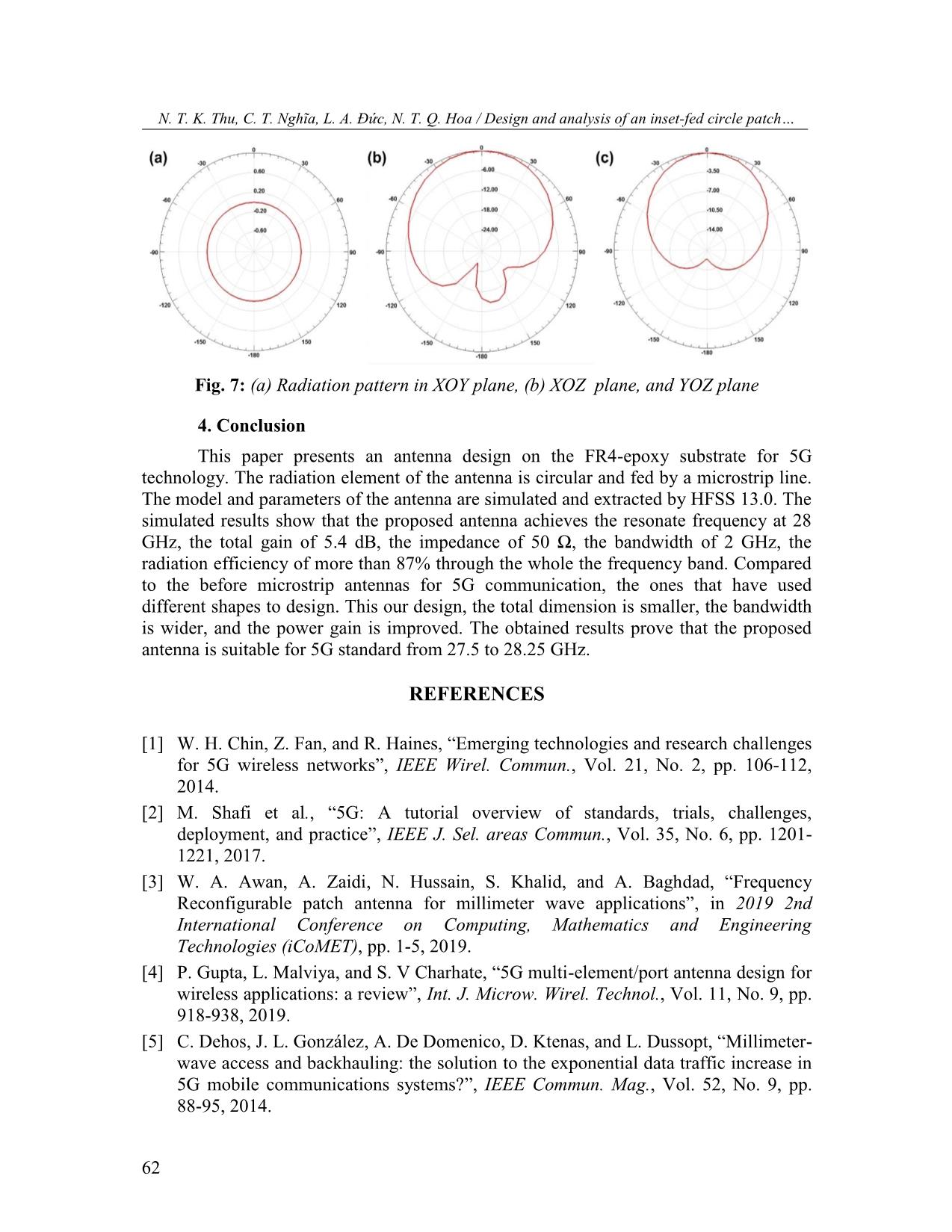
Trang 6
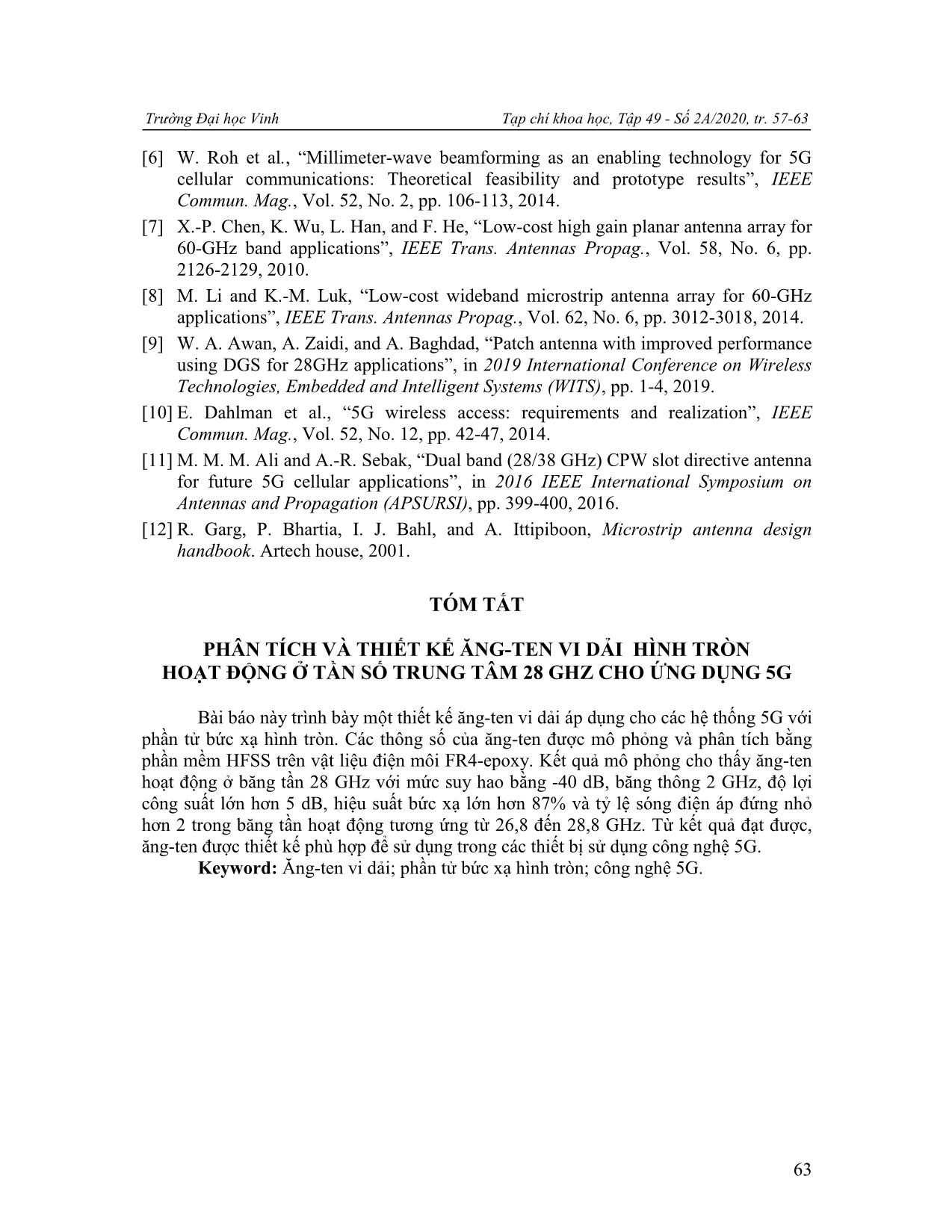
Trang 7
Bạn đang xem tài liệu "Design and analysis of an inset-fed circle patch microstrip antenna operated at 28 GHz for 5G application", để tải tài liệu gốc về máy hãy click vào nút Download ở trên
Tóm tắt nội dung tài liệu: Design and analysis of an inset-fed circle patch microstrip antenna operated at 28 GHz for 5G application
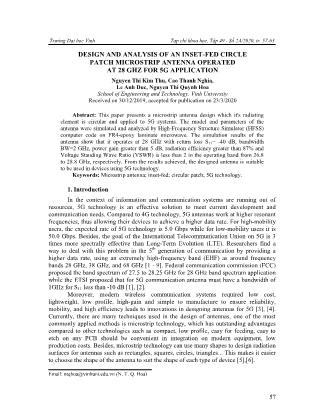
Trường Đại học Vinh Tạp chí khoa học, Tập 49 - Số 2A/2020, tr. 57-63 DESIGN AND ANALYSIS OF AN INSET-FED CIRCLE PATCH MICROSTRIP ANTENNA OPERATED AT 28 GHZ FOR 5G APPLICATION Nguyen Thi Kim Thu, Cao Thanh Nghia, Le Anh Duc, Nguyen Thi Quynh Hoa School of Engineering and Technology, Vinh University Received on 30/12/2019, accepted for publication on 23/3/2020 Abstract: This paper presents a microstrip antenna design which it's radiating element is circular and applied to 5G systems. The model and parameters of the antenna were simulated and analyzed by High-Frequency Structure Simulator (HFSS) computer code on FR4-epoxy laminate microwave. The simulation results of the antenna show that it operates at 28 GHz with return loss S11= -40 dB, bandwidth BW=2 GHz, power gain greater than 5 dB, radiation efficiency greater than 87% and Voltage Standing Wave Ratio (VSWR) is less than 2 in the operating band from 26.8 to 28.8 GHz, respectively. From the results achieved, the designed antenna is suitable to be used in devices using 5G technology. Keywords: Microstrip antenna; inset-fed; circular patch; 5G technology. 1. Introduction In the context of information and communication systems are running out of resources, 5G technology is an effective solution to meet current development and communication needs. Compared to 4G technology, 5G antennas work at higher resonant frequencies, thus allowing their devices to achieve a higher data rate. For high-mobility users, the expected rate of 5G technology is 5.0 Gbps while for low-mobility users it is 50.0 Gbps. Besides, the goal of the International Telecommunication Union on 5G is 3 times more spectrally effective than Long-Term Evolution (LTE). Researchers find a way to deal with this problem in the 5th generation of communication by providing a higher data rate, using an extremely high-frequency band (EHF) as around frequency bands 28 GHz, 38 GHz, and 68 GHz [1 - 9]. Federal communication commission (FCC) proposed the band spectrum of 27.5 to 28.25 GHz for 28 GHz band spectrum application while the ETSI proposed that for 5G communication antenna must have a bandwidth of 1GHz for S11 less than -10 dB [1], [2]. Moreover, modern wireless communication systems required low cost, lightweight, low profile, high-gain and simple to manufacture to ensure reliability, mobility, and high efficiency leads to innovations in designing antennas for 5G [3], [4]. Currently, there are many techniques used in the design of antennas, one of the most commonly applied methods is microstrip technology, which has outstanding advantages compared to other technologies such as compact, low profile, easy for feeding, easy to etch on any PCB should be convenient in integration on modern equipment, low production costs. Besides, microstrip technology can use many shapes to design radiation surfaces for antennas such as rectangles, squares, circles, triangles... This makes it easier to choose the shape of the antenna to suit the shape of each type of device [5],[6]. Email: ntqhoa@vinhuni.edu.vn (N. T. Q. Hoa) 57 N. T. K. Thu, C. T. Nghĩa, L. A. Đức, N. T. Q. Hoa / Design and analysis of an inset-fed circle patch For the 28 GHz band, Park et al. have proposed an 8-element array antenna with a bandwidth of 2.3 GHz but its structure is complex especially [7], [8]. Abbas Awan et al. have proposed a patch antenna with improved performance using DGS, however, it has a quite narrow bandwidth of 1.38 GHz [11]. A simple microstrip based structure has also been reported such as that by Khalily et al. providing a gain of 15.6 dBi within around 20 × 20 mm size, its bandwidth also only achieved from 27.3 to 29 GHz [9], [10], [11]. In this paper, we propose a microstrip antenna design with a circular radiation element, which operates at the 28 GHz band for 5G systems. The antenna is fed by a compact inset-fed, the overall dimensions of the antenna are 5.6 mm x 5.6 mm x 0.8 mm. The antenna operating frequency range is from 26.8 to 28.8 GHz, which is suitable for application in 5G communication. The antenna is designed and investigated based on the HFSS full-wave simulation software. 2. Structural Design and Simulations The proposed circle patch antenna using a microstrip line for feeding is given in Fig 1. The dimension of the overall antenna structure is 5.6 mm x 5.6 mm fabricated on an FR-4 substrate with a dielectric constant of 4.4, a substrate thickness of 0.8 mm, and a loss tangent of 0.02. The radiating and ground layers are made from copper, with thickness t of 0.035 mm and electric conductivity σ of 5.96×107 S/m. The radius of the patch, designed to operate at 28 GHz, the standard frequency for 5G communication antenna, is calculated using the formulas given in [12]. (1) ⁄ , * ( ) +- where (2) √ (3) r is the radius of the circular patch, fr is the operating frequency, h and r are the thickness and the dielectric constant of substrate. Apply the formulas (1), (2) and (3) to calculate the circular radius of the patch r=1.5 mm, L=6 mm. To achieve the desired results, the designers used the PSO algorithm (Particle Swarm Optimization) used in familiar Ansoft HFSS software for antenna dimensions. The optimization process is carried out by investigating the effect of the return loss S11 versus changes in the dimension of the radiation element's radius. Because the original antenna (r = 1.5 mm) operates at frequencies lower than 28 GHz, so the size of the antenna must be reduced in order for it to operate at higher frequencies. Initial initialization parameters are r from 1 to 1.5 mm, with step = 0.1 mm and the optimum results are calculated and displayed at 28 GHz. After optimization, the most suitable result is selected corresponding to r = 1.3 mm. Two symmetrical rectangular notches of dimensions m x g are etched in radiating circular patch with the 0.5 mm length (m) and 0.15 mm width (g). To obtain a characteristic impedance of 50 Ω, the feedline width (w) and length (k) are determined 0.3 mm and 1.8 mm respectively. The detailed dimensions of the proposed circular patch antenna are shown in Tab 1 and simulated by HFSS software. 58 Trường Đại học Vinh Tạp chí khoa học, Tập 49 - Số 2A/2020, tr. 57-63 Fig. 1: Schematic of proposed circle patch microstrip antenna (a) 3D view and (b)Top view Tab. 1: Dimensions of proposed patch antenna Parameters Value (mm) L 5.6 h 0.8 t 0.035 D 2.6 k 1.8 w 0.3 g 0.15 m 0.5 3. Results and Discussion 3.1. Return Loss Parameter The simulated S-parameter shown in Fig. 2 indicates that the value of return loss (S11) is -40 dB at 28 GHz with bandwidth ranging from 26.8 GHz to 28.8 GHz, which entirely covers 5G frequency band allocated from GHz 27.5 to 28.25 GHz. Fig. 2: Simulated S-parameter of circular patch microstrip antenna 59 N. T. K. Thu, C. T. Nghĩa, L. A. Đức, N. T. Q. Hoa / Design and analysis of an inset-fed circle patch 3.2. Voltage Standing Wave Ratio Voltage Standing Wave Ratio (VSWR) of the proposed circle patch antenna is shown in Fig. 3. The value of VSWR at 28 GHz is reported to be 1.25 which value is less than 2 indicating improved matching conditions. Fig. 3: VSWR of circular patch microstrip antenna 3.3. Smith Chart The Fig. 4 shown the scattering parameter S11 for the proposed circular patch microstrip antenna at the range of frequency 20 GHz -30 GHz on the Smith chart exhibits a good impedance matching of approximately 50 Ω at the resonate frequency. Fig. 4: Smith chart of circular patch microstrip antenna 60 Trường Đại học Vinh Tạp chí khoa học, Tập 49 - Số 2A/2020, tr. 57-63 3.4. Gain and Radiation Efficiency The gains of the proposed antenna were given in Fig. 5. As shown in Fig. 5, the proposed antenna provides a total maximum gain of 5.44 dB and the gains stay above 5 dB throughout the band. Fig. 5: Power gain 3D (a) and 2D versus frequency (b) of circular patch microstrip antenna The radiation efficiency and patterns of the proposed antenna are provided in Fig. 6 and Fig. 7. As shown in Fig. 6, the radiation efficiency of antenna obtains above 87% in the bandwidth ranging from 26.7 GHz to 28.25 GHz. The 3-D total gain confirms that the maximum power of the antenna could be achieved along the z-axis. In YOZ-plane and XOZ-plane, the radiation patterns of the designed antenna are quite similar to the directional radiation patterns with maximum power along the Z-axis, while it exhibits an omnidirectional radiation pattern in the XOY-plane Fig. 6: Radiation Efficiency of circular patch microstrip antenna 61 N. T. K. Thu, C. T. Nghĩa, L. A. Đức, N. T. Q. Hoa / Design and analysis of an inset-fed circle patch Fig. 7: (a) Radiation pattern in XOY plane, (b) XOZ plane, and YOZ plane 4. Conclusion This paper presents an antenna design on the FR4-epoxy substrate for 5G technology. The radiation element of the antenna is circular and fed by a microstrip line. The model and parameters of the antenna are simulated and extracted by HFSS 13.0. The simulated results show that the proposed antenna achieves the resonate frequency at 28 GHz, the total gain of 5.4 dB, the impedance of 50 Ω, the bandwidth of 2 GHz, the radiation efficiency of more than 87% through the whole the frequency band. Compared to the before microstrip antennas for 5G communication, the ones that have used different shapes to design. This our design, the total dimension is smaller, the bandwidth is wider, and the power gain is improved. The obtained results prove that the proposed antenna is suitable for 5G standard from 27.5 to 28.25 GHz. REFERENCES [1] W. H. Chin, Z. Fan, and R. Haines, “Emerging technologies and research challenges for 5G wireless networks”, IEEE Wirel. Commun., Vol. 21, No. 2, pp. 106-112, 2014. [2] M. Shafi et al., “5G: A tutorial overview of standards, trials, challenges, deployment, and practice”, IEEE J. Sel. areas Commun., Vol. 35, No. 6, pp. 1201- 1221, 2017. [3] W. A. Awan, A. Zaidi, N. Hussain, S. Khalid, and A. Baghdad, “Frequency Reconfigurable patch antenna for millimeter wave applications”, in 2019 2nd International Conference on Computing, Mathematics and Engineering Technologies (iCoMET), pp. 1-5, 2019. [4] P. Gupta, L. Malviya, and S. V Charhate, “5G multi-element/port antenna design for wireless applications: a review”, Int. J. Microw. Wirel. Technol., Vol. 11, No. 9, pp. 918-938, 2019. [5] C. Dehos, J. L. González, A. De Domenico, D. Ktenas, and L. Dussopt, “Millimeter- wave access and backhauling: the solution to the exponential data traffic increase in 5G mobile communications systems?”, IEEE Commun. Mag., Vol. 52, No. 9, pp. 88-95, 2014. 62 Trường Đại học Vinh Tạp chí khoa học, Tập 49 - Số 2A/2020, tr. 57-63 [6] W. Roh et al., “Millimeter-wave beamforming as an enabling technology for 5G cellular communications: Theoretical feasibility and prototype results”, IEEE Commun. Mag., Vol. 52, No. 2, pp. 106-113, 2014. [7] X.-P. Chen, K. Wu, L. Han, and F. He, “Low-cost high gain planar antenna array for 60-GHz band applications”, IEEE Trans. Antennas Propag., Vol. 58, No. 6, pp. 2126-2129, 2010. [8] M. Li and K.-M. Luk, “Low-cost wideband microstrip antenna array for 60-GHz applications”, IEEE Trans. Antennas Propag., Vol. 62, No. 6, pp. 3012-3018, 2014. [9] W. A. Awan, A. Zaidi, and A. Baghdad, “Patch antenna with improved performance using DGS for 28GHz applications”, in 2019 International Conference on Wireless Technologies, Embedded and Intelligent Systems (WITS), pp. 1-4, 2019. [10] E. Dahlman et al., “5G wireless access: requirements and realization”, IEEE Commun. Mag., Vol. 52, No. 12, pp. 42-47, 2014. [11] M. M. M. Ali and A.-R. Sebak, “Dual band (28/38 GHz) CPW slot directive antenna for future 5G cellular applications”, in 2016 IEEE International Symposium on Antennas and Propagation (APSURSI), pp. 399-400, 2016. [12] R. Garg, P. Bhartia, I. J. Bahl, and A. Ittipiboon, Microstrip antenna design handbook. Artech house, 2001. TÓM TẮT PHÂN TÍCH VÀ THIẾT KẾ ĂNG-TEN VI DẢI HÌNH TRÒN HOẠT ĐỘNG Ở TẦN SỐ TRUNG TÂM 28 GHZ CHO ỨNG DỤNG 5G Bài báo này trình bày một thiết kế ăng-ten vi dải áp dụng cho các hệ thống 5G với phần tử bức xạ hình tròn. Các thông số của ăng-ten được mô phỏng và phân tích bằng phần mềm HFSS trên vật liệu điện môi FR4-epoxy. Kết quả mô phỏng cho thấy ăng-ten hoạt động ở băng tần 28 GHz với mức suy hao bằng -40 dB, băng thông 2 GHz, độ lợi công suất lớn hơn 5 dB, hiệu suất bức xạ lớn hơn 87% và tỷ lệ sóng điện áp đứng nhỏ hơn 2 trong băng tần hoạt động tương ứng từ 26,8 đến 28,8 GHz. Từ kết quả đạt được, ăng-ten được thiết kế phù hợp để sử dụng trong các thiết bị sử dụng công nghệ 5G. Keyword: Ăng-ten vi dải; phần tử bức xạ hình tròn; công nghệ 5G. 63
File đính kèm:
 design_and_analysis_of_an_inset_fed_circle_patch_microstrip.pdf
design_and_analysis_of_an_inset_fed_circle_patch_microstrip.pdf

